

LIFE. Dr. Seuss Draws Anti-Japanese Cartoons During WWII, Then Atones with Horton Hears a Who! Before Theodor Seuss Geisel AKA Dr.
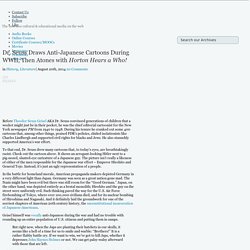
Seuss convinced generations of children that a wocket might just be in their pocket, he was the chief editorial cartoonist for the New York newspaper PM from 1940 to 1948. During his tenure he cranked out some 400 cartoons that, among other things, praised FDR’s policies, chided isolationists like Charles Lindbergh and supported civil rights for blacks and Jews. He also staunchly supported America’s war effort. To that end, Dr. Seuss drew many cartoons that, to today’s eyes, are breathtakingly racist. In the battle for homeland morale, American propaganda makers depicted Germany in a very different light than Japan.
Geisel himself was vocally anti-Japanese during the war and had no trouble with rounding up an entire population of U.S. citizens and putting them in camps. But right now, when the Japs are planting their hatchets in our skulls, it seems like a hell of a time for us to smile and warble: “Brothers!” He wrote a children’s book. via Dartmouth. Racism And The Atomic Bomb. WGBH American Experience . Victory in the Pacific . Online Forum. Question: With some 13 divisions of Japanese infantry on Kyushu why did we not drop the atomic bomb there, on what would have been a purely military target?
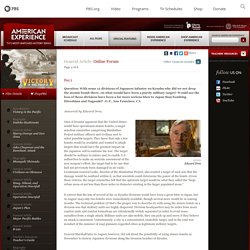
Would not the loss of those divisions have been a far more serious blow to Japan than bombing Hiroshima and Nagasaki? -G.F., San Francisco, CA Answered by Edward Drea: Edward Drea Once it became apparent that the United States would have operational atomic bombs, a target selection committee comprising Manhattan Project military officers and civilians met to select possible targets. World War II's Racist 'Punch' Against Japan. The American military has been widely criticized, from within and from without, for not paying enough attention to the cultures of Iraq and Afghanistan.
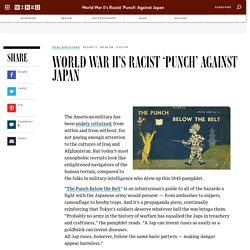
But today’s most xenophobic recruits look like enlightened navigators of the human terrain, compared to the folks in military intelligence who drew up this 1945 pamphlet. "The Punch Below the Belt" is an infantryman’s guide to all of the hazards a fight with the Japanese army would present — from ambushes to snipers, camouflage to booby traps. And it’s a propaganda piece, continually reinforcing that Tokyo’s soldiers deserve whatever hell the war brings them. "Probably no army in the history of warfare has equalled the Japs in treachery and craftiness," the pamphlet reads. "A Jap can invent ruses as easily as a goldbrick can invent diseases. Earlier in the war, a similar document taught G.I.s "How to Spot a Jap" among other Asians. MIS bulletin 6 07 medium. Untitled. Dropping the Bomb: A Historiographical Review of the Most Destructive Decision in Human History I The Hampton Institute.
Dropping the Bomb: A Historiographical Review of the Most Destructive Decision in Human History Derek Ide I Geopolitics I History I June 19th, 2014 The historiography of the atomic bomb can be roughly categorized into three camps: traditionalists, revisionists, and middle-ground "consensus" historians. [1] Traditionalists, also referred to as orthodox[2] historians and post-revisionists, studying the atomic bomb generally accept the view posited by the Truman administration and articulated most clearly in Henry Stimson's 1947 Harper's Magazine article.[3] In short, this argument assumes that the use of the atomic bombs against Japan was justifiable on military grounds in order to prevent a costly invasion of the Japanese home islands.
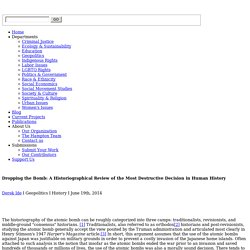
Often attached to such analysis is the notion that insofar as the atomic bombs ended the war prior to an invasion and saved hundreds of thousands or millions of lives, the use of the atomic bombs was also a morally sound decision. American Experience . Race for the Superbomb . David Holloway on: Soviet Reactions to Hiroshima. The Bomb Didn’t Beat Japan… Stalin Did. The U.S. use of nuclear weapons against Japan during World War II has long been a subject of emotional debate.

Initially, few questioned President Truman’s decision to drop two atomic bombs, on Hiroshima and Nagasaki. But, in 1965, historian Gar Alperovitz argued that, although the bombs did force an immediate end to the war, Japan’s leaders had wanted to surrender anyway and likely would have done so before the American invasion planned for November 1. Their use was, therefore, unnecessary. Obviously, if the bombings weren’t necessary to win the war, then bombing Hiroshima and Nagasaki was wrong. Eisenhower Institute at Gettysburg College - WWII Soviet Experience.
The Soviet Experience in World War Two By JT Dykman Overview Americans have little conception of the Soviet Union's experience in World War II.

No cities in the United States were besieged, not a single bomb was dropped by an enemy airplane on any of our 48 states, no part of our population was enslaved, starved or murdered, and not one village, town or city was completely destroyed or even heard a shot fired in anger. Don’t forget how the Soviet Union saved the world from Hitler. People look at photos on the "We have won!
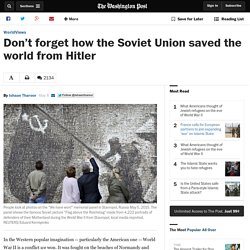
" memorial panel in Stavropol, Russia May 5, 2015. The panel shows the famous Soviet picture "Flag above the Reichstag" made from 4,222 portraits of defenders of their Motherland during the World War II from Stavropol, local media reported. REUTERS/Eduard Korniyenko. Hiroshima. Upload.wikimedia.org/wikipedia/commons/6/6f/Map-Germany-1945.svg. Dawn of Nuclear Arms, Declassified. It was near midnight when John Coster-Mullen, the author of “Atom Bombs: The Top Secret Inside Story of Little Boy and Fat Man,” was scrutinizing one image among hundreds newly released by Los Alamos, the birthplace of the bomb.
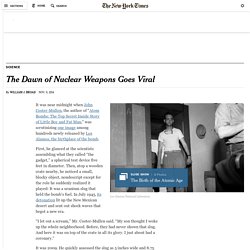
First, he glanced at the scientists assembling what they called “the gadget,” a spherical test device five feet in diameter. Then, atop a wooden crate nearby, he noticed a small, blocky object, nondescript except for the role he suddenly realized it played: It was a uranium slug that held the bomb’s fuel. In July 1945, its detonation lit up the New Mexican desert and sent out shock waves that begot a new era. “I let out a scream,” Mr. Clamor in the East: Legacy of Yalta and Potsdam; Cold War Sealed Germany's Division.
When the war in Europe ended with Nazi Germany's surrender in May 1945, the victorious Americans, British, French and Soviets did not envision the permanent division of Germany and Berlin.

These long-term divisions occurred as the United States and its allies squared off against the Soviet Union and its allies in the postwar confrontation that became known as the cold war. Yet the divisions had their roots in decisions made during the war and just afterward, when, as Norman J. G. Pounds, an Indiana University professor of geography, once put it, ''the development of the cold war was only vaguely sensed, and the division of Germany was not expected to last more than a very few years.'' Zones of Occupation.
Lesson 1: Sources of Discord, 1945–1946. Activity 1.
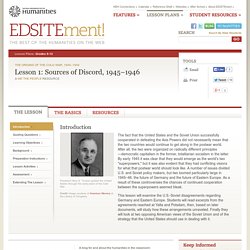
Plans for Postwar Europe During conferences at Yalta (February 1945) and Potsdam (July-August 1945) the Allies concluded agreements for the postwar world; the most important concerned the fate of Germany and Eastern Europe. In this activity students will consider those agreements so that they will understand how they later unraveled. Russia, Japan renew quest for elusive WWII peace treaty. No pushovers when it comes to protecting their countries' national… (Kirill Kudryavtsev / European…) World War II lingers for Russia and Japan. Nearly 68 years after the fighting ended, the two Asian powers have yet to sign a peace treaty. That could change now that the leaders of both countries have solid nationalist credentials and could pull off what analysts call a “Nixon-to-China moment.” Like stridently anti-Communist President Nixon, who traveled to Beijing in 1972, Russian President Vladimir Putin and Japanese Prime Minister Shinzo Abe could hardly be accused of failing to defend their countries' national interests.
PHOTOGRAPHS OF HIROSHIMA AND NAGASAKI (GENSUIKIN) 1. The Huge Atomic Cloud / The Mushroom Cloud Blowing Up The atomic cloud (mushroom cloud) produced just after the burst is one of the most intensive characteristics of the A-bomb explosion. The Hiroshima Meteorological Observatory reported that just after the flash, black smoke rose from the ground up to the sky reaching an altitude of several thousand meters, and covered the whole city.
When the fireball disappeared, the angry clouds, like grey smoke, rose and reached an altitude of 8,000 meters in 5 minutes after the explosion. One of the EnolaGay crew recorded in his flight diary, "9:00a.m.....Clouds were observed. Hiroshima and Nagasaki: Photos From the Ruins. One scene shared by all of the 20th century's bloodiest conflicts might have been lifted straight from The Road Warrior, or a Beckett play: spectral landscape; buildings obliterated; blasted trees; lifeless wasteland. The photographs in this gallery, for instance—pictures that starkly reference every bleak, war-battered panorama from Gettysburg to Verdun to Stalingrad to Chosin Reservoir to Pork Chop Hill—were made in September, 1945, in Hiroshima and Nagasaki, Japan.
But far from chronicling the aftermath of a sustained, slogging campaign, these pictures—none of which were published in LIFE magazine—depict the devastation produced in a few unspeakably violent seconds. Here, LIFE.com presents pictures from both cities taken in the weeks and months following the bombings—bombings that killed a combined 120,000 people outright, and tens of thousands more through injury and radiation sickness. A Photo-Essay on the Bombing of Hiroshima and Nagasaki. A Decade of American Foreign Policy 1941-1949 - Potsdam Conference.
Cold War: Potsdam PC. Introduction. Could Stalin Have Been Stopped? by István Deák. Yalta (Crimea) Conference. The Tehran Conference. World War II : Documents. A Decade of American Foreign Policy 1941-1949 - Potsdam Conference. Yalta (Crimea) Conference. PHOTOGRAPHS OF HIROSHIMA AND NAGASAKI (GENSUIKIN) Hiroshima and Nagasaki: Photos From the Ruins. A Photo-Essay on the Bombing of Hiroshima and Nagasaki. GCSE Bitesize: Yalta and Potsdam - the basics. THE ATLANTIC CHARTER. Tokyo firebombing and unfinished U.S. business. War. 1. Map interactive: Visualizing firebomb damage done to Japan during WWII through US analogy. Japanese Cities. Joint Message of Assistance to the Soviet Union from President Roosevelt and Prime Minister Churchill : August 15, 1941. Inter-Allied Council Statement on the Principles of the Atlantic Charter : September 24, 1941. Tokyo firebombing and unfinished U.S. business. Message from the President to the Emperor of Japan December 6. Japanese Note to the United States December 7, 1941.
The National Archives Learning Curve. US Neutrality- Europe/Asia. England’s Guilt (1939) History - World Wars: Pearl Harbor: A Rude Awakening. The Failure of Diplomacy, September–December 1941. The Tehran Conference. The Moscow Conference, October 1943. Joint Message of Assistance to the Soviet Union from President Roosevelt and Prime Minister Churchill : August 15, 1941. Inter-Allied Council Statement on the Principles of the Atlantic Charter : September 24, 1941. President Roosevelt's Message To Congress on the Atlantic Charter.
THE ATLANTIC CHARTER. Twitter. Twitter. The National Archives Learning Curve. Map_interactive_visualizing_firebomb_damage_done_to_japan_during_wwii_through. Japanese Cities. Japanese Note to the United States December 7, 1941. Message from the President to the Emperor of Japan December 6. United States Note to Japan November 26, 1941. Hitler2.jpg (301×424) Rote.jpg (482×690) Niemals.jpg (515×742) Wille.jpg (312×456) 1927.jpg (848×605) 1920a.jpg (786×589) Early Nazi Posters. England’s Guilt (1939) We Demand. The National Archives Learning Curve. History - World Wars: World War Two Movies. Inter-Allied Council Statement on the Principles of the Atlantic Charter : September 24, 1941. Joint Message of Assistance to the Soviet Union from President Roosevelt and Prime Minister Churchill : August 15, 1941. THE ATLANTIC CHARTER. US Neutrality- Europe/Asia.
US Neutrality- Europe/Asia. The National Archives Learning Curve. World War II Battles - Pacific Theater 1941-1945. World War II in the Pacific. The Failure of Diplomacy, September–December 1941. The Road to Pearl Harbor: The United States and East Asia, 1915–1941. History - World Wars: Pearl Harbor: A Rude Awakening. World War II : Documents. History - World Wars: World War Two Movies. Wille.jpg (312×456) 1927.jpg (848×605) 1920a.jpg (786×589) England’s Guilt (1939) We Demand. German Propaganda Archive (Guide Page) Nazi Propaganda (Pre-1933 Material) Early Nazi Posters.